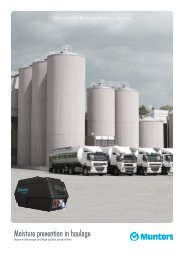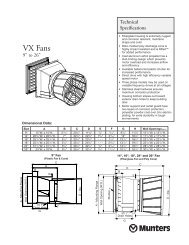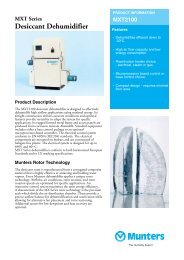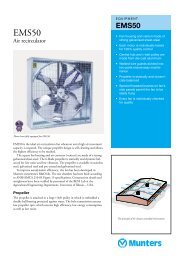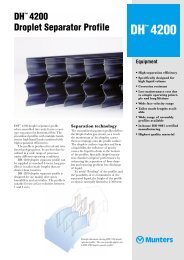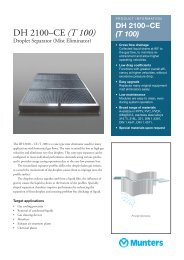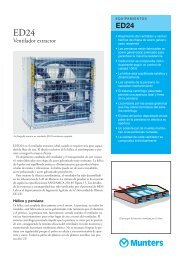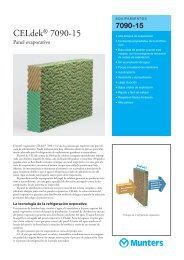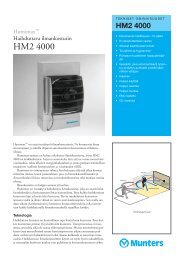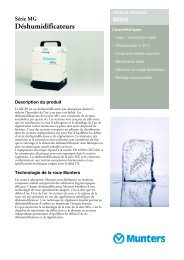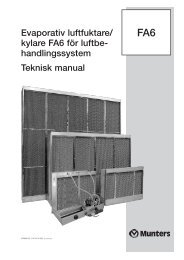Annual Report 2006 - Munters
Annual Report 2006 - Munters
Annual Report 2006 - Munters
You also want an ePaper? Increase the reach of your titles
YUMPU automatically turns print PDFs into web optimized ePapers that Google loves.
Value in use is generally measured using discounted cash-flow models, whichrequires assumptions of a discount rate, future cash flows and the expensesnecessary to create the assessed cash flows.Any previously reported impairment is reversed if the recovery value isconsidered to exceed the reported value. No reversal occurs of an amountgreater than what would cause the reported value to correspond to what itwould have been if no impairment had been reported in a prior year.Goodwill is impairment tested using the following method. The goodwillvalue established on the date of acquisition is distributed among cashgeneratingunits or groups of cash-generating units, which are expected tocontribute advantages from synergistic effects resulting from the acquisition.Assets and liabilities already in the Group at the time of acuisition can beassigned to these cash-generating units. Each such cash flow to which goodwillis distributed corresponds to the lowest level of the Group at which goodwill ismonitored in the management of the company. This is a unit of the Group that isnot larger than a segment – that is, a division or geographic region in theGroup’s segment reporting. Goodwill impairment is not reversed.Inventories, etc.Inventory is valued at the lower of acquisition cost or net sales value (fair value).Required impairments are made for obsolescence based on each item’s ageand inventory turnover rate. Acquisition cost is determined by applying the firstin,first-out method or weighted average prices, if that method results in a goodapproximation of the first-in-first-out method. For internally manufacturedproducts, the acquisition value consists of direct manufacturing costs plus areasonable share of indirect manufacturing costs. Interest expenses are notincluded in inventories. Normal capacity utilization has been taken into accountin valuations.Work in progress on behalf of another partyWork in progress on behalf of another party consists of committed expensesattributable to currently incomplete work.ReceivablesReceivables are reported in the amounts at which they are expected to be paid,based on individual assessment.Cash and cash equivalentsCash and cash equivalents are defined as cash and bank balances plus currentinvestments with maturity periods not exceeding three months. Utilized overdraftfacilities are reported under short-term loans.EquityExpenses for the purchase of own shares reduce equity in both the ParentCompany and the Group. When these shares are sold, the proceeds of the saleare included in equity.Loan liabilitiesLoan liabilities are initially reported in the amounts received, net after deductionof transaction costs. During subsequent periods, loan liabilities are reported asthe total of outstanding payment obligations in accordance with the effectiveinterest method. Interest expenses are reported in the income statements forthe various periods.ProvisionsProvisions are reported when the Group has or may be considered to have anobligation as a result of events that have occurred and where it is probable thatpayment will be required to fulfill the obligation. An additional prerequisite is thatit must be possible to reliably estimate the amount to be paid.A provision is made for restructuring measures when a detailed, formal planof the measures exists and well-founded expectations have been createdamong those who will be affected by the measures.Employee benefitsWithin the Group, there are several defined-contribution plans and severaldefined-benefit plans and other long-term employee benefits, including certainwith management assets in special trusts or the equivalent. Pension plans aremainly funded through premiums paid by the various Group companies and bythe employees. Independent actuaries compute the size of the commitments ofthe various plans and reassess plan commitments every year.Regarding defined-benefit plans, pension costs are calculated using theprojected unit credit method, so that the cost is distributed over the employee’sworking life. These commitments are valued at the present value of theanticipated future payments calculated using a discount rate that correspondsto the interest on grade A commercial paper or government bonds with aremaining term that approximately corresponds to that of the commitments. Forfunded plans, the pension commitment is reported net after deduction of theplan assets. Funded plans with net assets – that is, with assets in excess oftheir commitments – are reported as fixed assets. Actuarial gains and losses arereported against equity, net after deferred tax, in the period they occurred.In Sweden, special employers’ contributions pertaining to actuarial gains/losses are reported in equity.Other long-term employee benefits include benefits in conjunction withjubilee or other benefits to long-term employees. <strong>Report</strong>ing of these benefitsdiffers from defined-benefit plans whereby actuarial gains and losses arereported immediately and all expenses pertaining to employment duringprevious periods are reported immediately in the income statement.The Group’s payments relating to defined-contribution plans are reported asan expense during the period the employee performed the services to which thecontribution relates.Stock options programEmployees have paid a market premium for the stock options program that<strong>Munters</strong> has implemented (see Note 28). The stock option programs contain asubsidy implying that the employee receives the equivalent of 40 or 60 percent,respectively, of the option premium in the form of a cash bonus, provided theoption holder is employed during the period when the options may beexercised. This subsidy and the related social security payments are calculatedand allocated as a personnel cost over the vesting period – that is, from thetime of issuance of the options until the vesting conditions have been fulfilled.Warranty commitmentsWarranty costs are booked as cost of goods sold. Provisions for warranty costsare calculated at a standard rate in an amount that corresponds to averagewarranty costs in relation to sales in the most recent 24-month period, with anadjustment for known warranty claims exceeding the standard provision.Provisions for warranty commitments are related to the stated warranty period.LeasingLeasing is classified either as financial or operative leasing. Leasing in which<strong>Munters</strong> adopts essentially the same legal position as in direct ownership of theasset is classified as financial leasing. <strong>Report</strong>ing of financial leasing entailsrecognizing a fixed asset as an asset item in the balance sheet, at the lower ofthe market value of the asset and the estimated present value of the underlyinglease payments, and initially reporting a corresponding liability. The asset isdepreciated according to plan over its useful life, while the leasing payments arereported as interest and amortization of the liability. For operational leasing, theleasing payments are expensed in the income statement over the leasingperiod.RevenueNet sales are booked at the sale value after deduction of discounts and valueadded tax and other taxes.Income from the sale of goods is reported upon delivery, at which pointessentially all risks and rights are transferred to the purchaser. This normallyimplies that sales are reported on delivery to the customer in accordance withthe conditions of sale.Income from major project assignments is reported in relation to the degreeof completion on the closing date, provided the profit can be reliably calculated.Degree of completion is determined mainly on the basis of committed projectcosts in relation to estimated project costs upon completion. Any expectedlosses are expensed directly.In the MCS Division, there are numerous small projects with shortcompletion periods (the average being between two and 12 weeks). Forpractical reasons, income from such projects is reported on completion inconnection with the issuing of a final invoice to the customer.Key categories of revenue are defined in Note 4, whereby Dehumidificationand HumiCool refer to the sale of goods and MCS refers to services rendered.Interest income on receivables is calculated using the effective interestmethod. Interest income includes the accrued amount of transaction costs andpossible discounts, premiums and other differences between the original valueof the receivable and the amount received when due.Research and development costsThe Group’s expenses for research and development do not meet theestablished requirements for reporting as assets and have thus, as in previousyears, been expensed as they were incurred during the year.50 M U N T E R S A N N U A L R E P O R T 2 0 0 6



